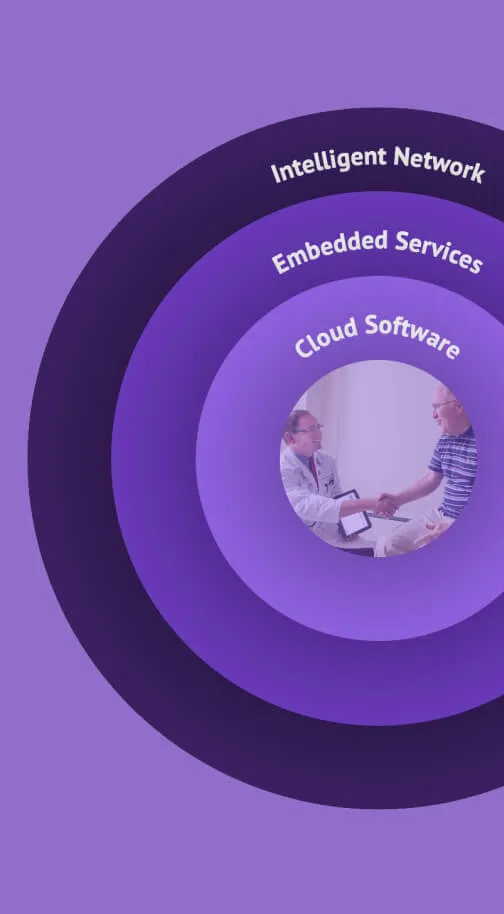Picture this: you’re a physician with a patient in front of you who recently had to go to the ER. The ER sent your practice a digital fax about the encounter, and there may or may not be a PDF in your clinical inbox with more information. None of that data has been added to your patient’s chart, so it’s not immediately usable. You’re 10 minutes into this follow-up visit, with three more encounters lined up. How do you make an informed clinical decision? That’s a challenge physicians face every day —and why healthcare interoperability is so important to informed care delivery.
Healthcare data interoperability is invaluable for clinical decision making, care coordination, and compliance with regulatory programs such as MIPS (Merit-based Incentive Payment System) and the MACRA (Medicare Access and CHIP Reauthorization Act) law. But many physicians report that these vast new volumes of disorganized data are contributing to their sense of overload and burnout.
There’s interoperability that meets the basic definition, and then there’s interoperability that works. Read on to understand the difference—and what’s necessary to leverage its potential while easing the burden on clinicians.
What Is Interoperability in Healthcare?
Interoperability in healthcare refers to the ability of different healthcare IT systems—whether they’re used by clinicians, laboratories, pharmacies, or hospitals—to exchange information. Electronic Heath Record (EHR) systems typically exchange data that is already labeled, such as problems, allergies, medications, test results, and so on. When HIT systems are interoperable, they’re able to communicate and share this information so that it can be used by its recipients.
According to the Health Information and Management Systems Society (HIMSS), interoperability standards for health information exchange must allow data sharing across diverse healthcare entities regardless of the EHR vendor or system. Standardizing the interoperability of healthcare information systems enables healthcare providers to review recent and historical patient data and make more informed care decisions.
The goal of healthcare interoperability is for different care providers to easily share health information, no matter which care site it came from or which HIT system was used. The reality, as any physician or healthcare provider knows, is much more complicated. Simply adhering to healthcare data standards may make a platform or software interoperable by definition, but that’s not enough.
Think of patient data that arrives via fax or is emailed as a PDF attachment: technically, it has been shared, but until it is incorporated into the patient chart, it’s not ready to use. Beyond creating the necessary connections, healthcare platforms should also transform external information into actionable insights and surface them at the point of care.
Importance of Interoperability for Care Coordination
Interoperability is no longer just a technical requirement but a fundamental aspect of delivering patient-centered, coordinated care. Interoperability serves as a key enabler for clinical integration—defined in healthcare regulations as the process of aligning patient care across the healthcare continuum to improve quality, access, and reduce costs. For clinical integration to be successful, it requires the sharing of data between providers.
Interoperability and Health Information Exchange (HIE) facilitate effective collaboration across the entire healthcare ecosystem, which includes a wide variety of healthcare providers—primary care physicians, specialists, hospitals, laboratories, imaging centers, pharmacies, and even in-home caregivers. Without interoperability, there is a risk of fragmented care, where each clinician or facility works in isolation, potentially leading to errors, inefficiencies, and poor patient outcomes. Knowing that your patient already had a CT scan at the ER, for example, can keep you from ordering again, saving time and money while also reducing the patient’s radiation exposure.
Interoperability as Part of MACRA and MIPS
For healthcare practitioners, understanding the role of interoperability within the broader context of the 2015 MACRA legislation is critical. The Merit-Based Incentive Payment System (MIPS), a Quality Payment Program established under MACRA, incorporates interoperability as a key component for performance measurement. Clinicians are incentivized to adopt technologies that support data sharing across systems, ensuring that patients receive comprehensive care through collaboration among multiple healthcare providers. Under MIPS, practitioners must demonstrate their ability to use certified EHR technology (CEHRT) to improve patient outcomes, streamline care, and lower costs to deliver it.
The MIPS program evaluates healthcare providers based on four performance categories: Quality, Cost, Improvement Activities (IA), and Promoting Interoperability (PI). The Promoting Interoperability category specifically focuses on how well clinicians can leverage EHRs and other health IT systems to improve the quality of care and reduce costs through better data exchange.
Medical practices and health systems using athenahealth solutions achieved MIPS program excellence in Program Year 2022. Practices using athenaOne bested the national average in the Promoting Interoperability category score by two percentage points, achieving a 96.94% PI score vs. the national average of 94.94%.1
Interoperability and Value Based Care
MACRA’s influence extends beyond MIPS by providing a framework for value-based care. By linking provider reimbursement to quality and efficiency metrics, MACRA incentivizes healthcare practices to use interoperable systems that allow them to work together more efficiently to improve patient health outcomes and reduce overall healthcare costs.
Furthermore, being able to demonstrate the use of a robust and interoperable IT infrastructure is a key requirement of many value-based care models. Providers and medical practices who wish to participate in these models must show how they are producing better patient outcomes while controlling costs, which requires the more holistic view of a patient’s care that interoperability enables. As value-based care programs grow, interoperability that moves beyond mere data exchange will be necessary to succeed, especially in shared risk models and global capitation.
What Makes an EHR Interoperable?
An interoperable EHR is characterized by its ability to send, receive, and integrate data accurately and efficiently across different systems and platforms. Interoperability is what sets EHRs apart from electronic medical records (EMRs). EHRs and EMRs are not identical. In the simplest terms, an EMR is a digital version of the patient record; it’s confined to one provider, medical practice, or healthcare system, and is not designed for ease of sharing. For an EHR to be truly interoperable, it must meet three essential criteria: security, functionality, and usefulness.
- Security: The integrity and confidentiality of patient data are paramount. Interoperable systems must meet stringent security standards to protect sensitive health information during transmission. This includes encryption, secure access protocols, and adherence to regulatory frameworks such as HIPAA (Health Insurance Portability and Accountability Act).
- Functionality: Interoperable systems need to be functional, meaning they must support the full exchange of relevant data—whether structured or unstructured—across disparate healthcare systems. This involves the seamless transmission of clinical data such as lab results, medication histories, and imaging reports, without the loss or alteration of critical information.
- Usefulness: For interoperability to be useful in clinical practice, the data coming from different sources must be correctly integrated into a patient’s record. This means that information should be accurately mapped to the correct fields in the EHR, enabling clinicians to use it for timely decision-making. Furthermore, the data must be surfaced in the clinician’s workflow in a way that adds value, not overwhelm them with unnecessary details.
The most sophisticated healthcare interoperability platforms do more than just exchange data and interpret basic information. Often using healthcare AI capabilities such as optical character recognition, computer vision and machine learning, these EHR systems excerpt and insert information where it belongs to give clinicians the right information, when and where they need it. Doing this makes it possible to enhance care delivery while combatting the data overload that can contribute to physicians’ sense of burnout.
Experience Healthcare Interoperability That Works: athenaOne®
Now that you know the meaning of “interoperable” and why interoperability is important in healthcare, you see why it’s important to choose a platform that helps deliver a complete picture of your patient without the data overload. At athenahealth, we've made the interoperability of electronic health records a core function of our platform.
Medical practices using our athenaOne solution connect to a broad interoperable network from day one. They have immediate access to 277K+ built-in clinical integrations, including direct connections to labs, imaging centers, pharmacies, and more.2 What's more, they’re automatically connected to 160K+ clinicians on the athenaOne network.3 All of those connections are created and managed by athenahealth—the medical practice doesn’t have to invest in technology or maintain the network connection.
We also know that ambulatory practices need more than data exchange alone—they want their data to enhance care while avoiding information overload. That’s why our focus is on designing experiences that deliver the right patient information at the right place and time. We define interoperability as providing not “all the news that fits,” but the right data to support you as you provide the best possible care for your patient.
Get to know the athenaOne difference.
- 2022 MIPS performance data, released by the Centers for Medicare and Medicaid Services.
- Based on athenahealth data as of Dec. 2024; M020
- Based on athenahealth data as of Dec. 2024; M010












